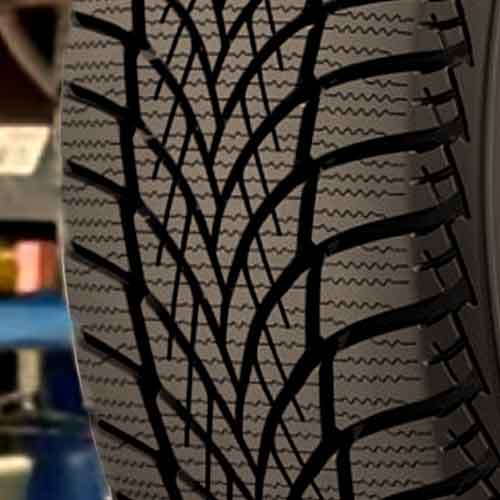With Goodyear’s WinterCommand Ultra, winter roads become less daunting. Let’s start things off, with this tire’s main highlights.

Table of Contents
Main Highlights
The Goodyear WinterCommand Ultra is pretty good when it comes to:
- Bump absorption and ride smoothness.
- Efficiently channeling away water to reduce hydroplaning risks.
- Snow traction, rivaling some of the top winter tires.
Though the tire lacks in:
- Wet grip and handling.
- Optimal performance on dry conditions, especially in braking.
- Ice traction, particularly when compared to competitors in its price range.
Info on Sizes: Goodyear WinterCommand Ultra comes in 15 to 18 inches, where all sizes have speed ratings of H only, load ratings of SL and XL, tread depth of 11/32″ (on all), and weight ranging from 18 pounds and going up to 28 lbs.
Also Note: Since the tire is one of best in terms of noise comfort, I added it to my list of top studless winter tires.
Tire Construction
The Goodyear WinterCommand Ultra comes with a directional tread pattern.

It’s tread is clearly divided up in to two sections, with the help of outer 2 circumferential grooves.
Here the outer ribs, or shoulder blocks, (notably the largest), showcase keen chamfered edges while preserving a siping pattern akin to the central lugs.
Moreover, their outer edges (sidewalls), showcase unique T-shaped biters.
Moving towards the middle, lugs seem segmented, but closer inspection reveals that, they have in-groove notches rather than full-depth cuts.
These central lugs effortlessly merge with the adjacent blocks, culminating in a sharp V-shaped design.
And these blocks are further enriched with a ton of interlocking sipes arranged laterally.
Comfort Performance
Tire comfort hinges on two pivotal factors: the ride’s smoothness, which relates to stability and the capacity to absorb road irregularities, and its noise levels across varied surfaces.
These attributes are shaped by the tire’s construction, specifically its rubber composition, tread pattern, and sidewall design.
Let’s discuss both these factors.
Bumps Absorption
When it comes to handling bumps, tires, being the primary interface between the vehicle and road irregularities, play a crucial role alongside the vehicle’s suspension.
And here, a tire’s proficiency is determined by its absorption capabilities and overall stability.
Now the Goodyear WinterCommand Ultra excels in this area, where its performance is mainly due to its generous tread depth, combined with well engineered tread rubber, which although offers the needed pliability, also ensures tire’s overall stability.
So road shocks/bumps aren’t just soaked up by its compound, but are also controlled as well.
Noise Comfort
The tread design significantly affects a tire’s noise levels, where typically, larger tread gaps lead to increased noise due to air colliding with tread walls.
However, the Goodyear WinterCommand Ultra defies this norm, where its well engineered design ensures that while air enters the shoulder voids, it doesn’t collide with the tread walls, a primary noise source.
This design ensures the smooth passage of air, minimizing disturbances.
Furthermore, the tire incorporates a specialized rubber compound that reduces in-tread sound resonances.
Wet Performance
Tire performance on wet surfaces largely depends on the tire’s design and rubber composition.
These factors are engineered to ensure effective water displacement from the tread, which in turn guarantees superior wet grip and reduces the risk of hydroplaning.
Let’s check both these out.
Resistance to Hydroplaning
Hydroplaning occurs when water interrupts the tire’s contact with the road. To understand this, you must first know the main property of water, that it’s not compressible. So if it isn’t effectively channeled away, it forms a barrier, leading to traction loss.
Now all tires typically combat this with grooves, which guide water away, thereby diminishing the chances of aquaplaning (another word for it)
Having said that, the Goodyear WinterCommand Ultra is notably proficient here, as it efficiently dispels water, maintaining great float speeds.
Its unique directional tread pattern, marked by squared central lugs, forms channels in multiple directions, allowing for swift water evacuation.
Moreover, the tire features a well crafted contact patch that exerts added pressure on water, pushing it out with greater force.
Thanks to this design, most of the water is skillfully directed through the grooves, leaving minimal work for the sipes and thus enhancing its wet performance.
Wet Grip
The sipes in a tire handle the residual water not cleared by the grooves.
However, the Goodyear WinterCommand Ultra falls slightly short in this department.
While its grooves are effective, its sipes, owing to their relatively stiffer rubber composition, don’t provide optimal wet traction. (This is one of the tire’s few shortcomings).
Despite featuring interlocking sipes, the tire lacks multi-directional angles, crucial for multi-angled grip. And this negatively affects its wet handling capabilities and steering responsiveness.
However, it’s essential to note that when compared to other tires in its category, the difference is evident, but the tire still delivers a reasonable performance.
Fuel Economy
A tire’s fuel efficiency hinges on its weight and traction, both crucial determinants of rolling resistance.
To illustrate, a heavier tire with pronounced tread voids often undergoes greater lug flexing during maneuvers due to the increased pressure exerted on the lugs.
This flexing diverts energy from the actual motion of the tire, leading to energy wastage (in the form of heat, for the most part).
However, the Goodyear WinterCommand Ultra, designed with streamlined and aligned ribs, does a decent job here, leading with its limited rolling resistance.
Even so, there’s room for enhancement in its overall fuel efficiency I feel, especially when you consider its XL (load rated) sizes.
Dry Performance
While the efficiency of tires on wet and snowy roads is vital, their performance on dry surfaces, influenced primarily by the rubber’s contact with the road, is equally paramount.
This contact determines the tire’s grip and its steering response and handling.
Let’s check all these dimensions.
Dry Linear Grip
Linear grip pertains to the tire’s traction as it moves straight forward. This grip depends on the central tread’s contact with the road and is indicative of the tire’s braking efficiency.
In this context, the Goodyear WinterCommand Ultra exhibits certain limitations, especially when compared to other tires in its category.
Now it seems odd, that the tire lacks here, especially when you consider that its a lighter structure, having reinforcements under all lugs.
But the thing is the tire features more void ratio, with its laterally arranged lugs. Simply put, this lateral arrangement prevents optimal road contact as the tire rolls straight, resulting in compromised grip.
So you get below-average braking on this tire.
Dry Handling and Steering
A tire’s overall handling combines its grip with its lateral stability, (crucial for sharp responsiveness).
And here, while the Goodyear’s tire offers you with respectable lateral traction (as seen from its decent overall g-force readings), it still ranks below its peers. This shortfall is primarily attributed to its deficient directional grip.
So the tire comes with good enough lateral grip and steering response, but its slower braking renders corner entry sluggish.
Likewise, its less effective acceleration also affects its performance as it exits corners.
Thus, in terms of dry handling, the WinterCommand Ultra finds itself lagging behind its direct competitors.
Snow Traction
Snow traction revolves around a tire’s ability to penetrate, secure, and subsequently shed accumulated snow in/from its tread.
In other words, a good tire here would provide decent snow-to-snow contact, and create positive momentum, scooping up the snow.
And that’s exactly what the WinterCommand does here.
The tire offers interconnected grooves which ensure substantial and effective snow-to-snow contact, enhancing traction. Moreover, its directional pattern is pretty great at throwing snow backwards, getting decent overall acceleration.
To put it in perspective, its snow braking and handling is parallel to some of the best winter tires in the market.
For Your Info: Out of all it’s direct competitors, the Michelin X-Ice Snow (review) offers the best overall snow performance.
Tread Longevity
The lifespan of a tire’s tread is closely tied to two factors: rolling resistance and tread depth.
But how are they related?
Well rolling resistance is the obvious one.
While with greater tread depth, a tire would take longer to reach down to the point of needing replacement.
Though one thing to note here, is that, too much tread depth also increases rolling friction, and heat, ironically.
Now the Goodyear WinterCommand Ultra delivers a very average performance here, for a winter tire.
It although doesn’t offer any treadwear warranty. Yet, users can anticipate a reasonable mileage of around 35 to 40k miles from this tire without compromising on traction.
(And that’s a pretty good number if you ask me).
Ice Traction
Ice traction reflects a tire’s ability to adhere to and maneuver on exceptionally slippery ice surfaces. Considering the inherently slick nature of icy roads, which offer limited natural friction, you need right tires here, with soft rubber compositions and superior tread designs with biters.
Now, although the Goodyear Ultra is not too bad here, as a winter tire, its performance is still average, which should not be the case, given its price tag, I mean.
The tire notably lacks multi-directional siping and biters, essential for maintaining grip during icy cornering.
So unlike competitors such as the Blizzak WS90 (review), (which gives superior ice grip with its advanced siping strategy), the Goodyear WinterCommand Ultra delivers just an okay overall ice performance only.
To Conclude
The Goodyear WinterCommand Ultra showcases a mixed bag of performance across varied terrains and conditions.
Starting with comfort, it stands out with excellent bump absorption, ensuring a smooth ride, and an innovative design that reduces road noise.
On wet surfaces, it efficiently channels away water, diminishing hydroplaning risks. However, it could use some improvements in the wet grip department.
For dry conditions, its performance is below average, where the main culprit is its lacking linear grip.
For winter conditions, the tire does great in terms of snow traction, still can be improved in terms of ice.
Lastly, as the tire generates less rolling resistance, its overall tread life and fuel economy is doing okay.